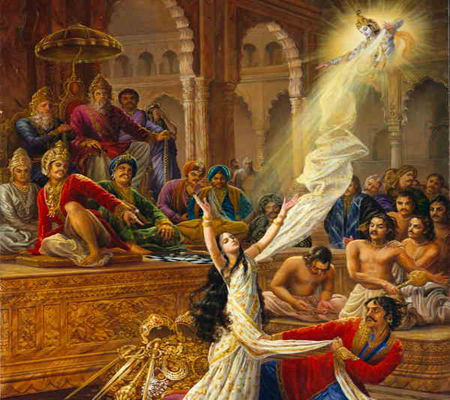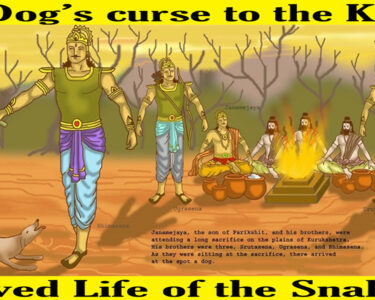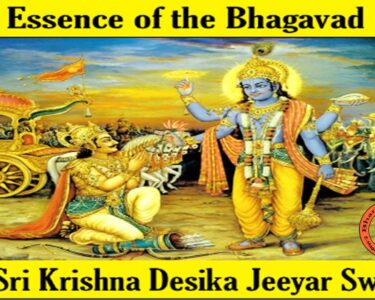(BRIEF OF SABHA PARVA)
“The second is the extensive parva called Sabha or the assembly, full of matter. The subjects of this parva are the establishment of the grand sabha by Paandavaas; their review of their servants; the description of the Lokapaalaas by (Devarishi) Naarada well-familiar with Devaloka; the preparations for the Rajasooya yagna; the destruction of Jaraasandha; the release by Vaasudeva (Sri Krishna) of the princes confined in the mountain-pass; the campaign of universal conquest by Paandavaas; the arrival of the princes at the Rajasooya yagna with tribute (gifts); the destruction of Shishupaala on the occasion of the (Rajasooya) yagna, in connection with offering of Arghya; Bhimasena making fun of Duryodhana in the sabha; Duryodhana’s sorrow and jealousy at the sight of the magnificent scale on which the arrangements had been made (for the Rajasooya yagna); the unhappiness of Duryodhana in consequence, and the preparations for the game of dice (gambling); the defeat of Yudhishthira at play by the clever Shakuni; the release by Dhritarashtra of his pained daughter-in-law Draupadi plunged in the sea of distress caused by the gambling, as of a boat tossed about by the violent waves. The attempts of Duryodhana to engage Yudhishthira again in the (gambling) game; and the exile of the defeated Yudhishthira with his brothers.
“These constitute what has been called by the great Vyaasa as the Sabha Parva. O best of Brahmanas, this (Sabha) parva is divided into seventy-eight (78) sections of two thousand, five hundred and seven (2,507) shlokas.
(BRIEF OF AARANYANKA PARVA)
“Then comes the third parva called Aaranyaka (relating to the forest). This parva treats of making of the way of Paandavaas to the forest and the citizens, following the wise Yudhishthira; Yudhishthira’s adoration of the God of day (Surya) according to the directions of Dhaumya, to be gifted with the power of maintaining the dependent Brahmanas with food and drink; the creation of food through the grace of the Surya; the expulsion by Dhritarashtra of Vidura who always spoke for his master’s good; Vidura’s coming to Paandavaas and his return to Dhritarashtra at the request of the latter; the wicked Duryodhana’s plottings to destroy the forest-travelling Paandavaas, being fueled thereto by Karna; the appearance of Vyaasa and his dissuasion of Duryodhana bent on going to the forest; the history of Surabhi; the arrival of Maitreya; his laying down to Dhritarashtra the course of action and his curse on Duryodhana; Bhima’s slaying of Kirmira in battle; the coming of Paanchaalas and the princes of Vrishni kula to Yudhishthira on hearing of his defeat at the unfair gambling by Shakuni.
“Dhananjaya’s (Arjuna’s) reducing the anger of (Sri) Krishna; Draupadi’s lamentations before Maadhava (Sri Krishna); (Sri) Krishna’s cheering her (Draupadi); the fall of Sauba also has been here described by the Rishi (Vyaasa); also (Sri) Krishna’s bringing Subhadra with her son (Abhimanyu) to Dwaraka; and Dhrishtadyumna bringing the (five) sons of Draupadi to Paanchaala; the entrance of Paandavaas into the romantic Dwaita vana; conversation of Bhima, Yudhishthira, and Draupadi; the coming of Vyaasa to Paandavaas and he providing Yudhishthira with the power of Pratismriti; then, after the departure of Vyaasa, the removal of Paandavaas to the forest of Kaamyaka (Kaamyaka vana); the wanderings of Arjuna of immeasurable skills in search of weapons; his battle with Mahaadeva (Lord Shiva) in the guise of a hunter; his meeting with the Lokapaalaas and receiving weapons from them; his journey to Indraloka for weapons and the consequent anxiety of Dhritarashtra.
“The wailings and lamentations of Yudhishthira on the occasion of his meeting with the worshipful great sage Brihadashwa. Here occurs the holy and highly pathetic story of Nala illustrating the patience of Damayanti and the character of Nala. Then the acquirement by Yudhishthira of the mysteries of dice from the same great sage (Brihadashwa); then the arrival of the Rishi Lomasha from heavens to where Paandavaas were, and the receipt by these high-souled dwellers (Paandavaas) in the forest of the information brought by the Rishi (Lomasha) of their brother Arjuna staying in the heavens; then the pilgrimage of Paandavaas to various sacred spots in accordance with the message of Arjuna, and their attainment of great merit and Dharma consequent on such pilgrimage; then the pilgrimage of the great sage Naarada to the shrine Putasta; also the pilgrimage of high-souled Paandavaas.
“Here is the deprivation of Karna of his ear-rings by (Lord) Indra. Here also is recited the sacrificial magnificence of Gaya; then the story of Agastya in which the Rishi ate up the Asura Vaataapi, and his marriage connection with Lopamudra from the desire of offspring. Then the story of Rishyasringa who adopted Brahmacharya mode of life from his very boyhood; then the history of (Parashu)Rama of great skills, the son of (Rishi) Jamadagni, in which has been narrated the death of Kaartaveerya and the Haihayaas; then the meeting between Paandavaas and Vrishnis in the sacred spot called Prabhasa; then the story of Su-kanya in which (Rishi) Chyavana, the son of Bhrigu, made the twin Ashwinis (Ashwini Devas), drink the Soma juice (from which they had been excluded by other Devas), at the yagna of king Sharyaati, and in which besides is shown how (Rishi) Chyavana himself acquired everlasting youth (as a boon from the grateful Ashwini Devas).
“Then has been described the history of king Mandhata; then the history of prince Jantu; and how king Somaka by offering up his only son (Jantu) in yagna obtained a hundred others; then the excellent history of the eagle and the pigeon; then the examination of king Shibi by (Lord) Indra, Agni, and Dharma; then the story of Ashtavakra, in which occurs the debate, at the yagna of Janaka, between that Rishi and the first of logicians, Bandi, the son of Varuna; the defeat of Bandi by the great Ashtavakra, and the release by the Rishi of his father from the depths of the ocean. Then the story of Yavakrita, and then that of the great Raibya; then the departure (of Paandavaas) for Gandhamadana (mountain) and their abode in the ashrama called Narayana; then Bhimasena’s journey to Gandhamadana at the request of Draupadi (in search of the sweet-scented flower). Bhima’s meeting on his way, in a grove of bananas, with Hanuman, the son of Pavana of great skills; Bhima’s bath in the tank and the destruction of the flowers therein for obtaining the sweet-scented flower (he was in search of); his consequent battle with the mighty Raakshasaas and Yakshas of great skills including Hanuman; the destruction of the Asura Jata by Bhima; the meeting (of Paandavaas) with the Rajarishi Vrishaparva; their departure for the ashrama of Arshtishena and abode therein; the fueling of Bhima (to acts of vengeance) by Draupadi. Then is narrated the ascent on the hills of Kailaasa by Bhimasena, his terrific battle with the mighty Yakshas headed by Hanuman; then the meeting of Paandavaas with Vaishravana (Lord Kubera), and the meeting with Arjuna after he had obtained for the purpose of Yudhishthira many divine weapons.
“Then Arjuna’s terrible encounter with Nivatakavachaas dwelling in Hiranyapura, and also with Paulomas, and Kaalakeyas; their destruction at the hands of Arjuna; the commencement of the display of divine weapons by Arjuna before Yudhishthira, the prevention of the same by Naarada; the descent of Paandavaas from Gandhamadana; the seizure of Bhima in the forest by a mighty snake huge as the mountain; his release from the coils of the snake, upon Yudhishthira’s answering certain questions; the return of Paandavaas to the Kaamyaka vana.
“Here is described the reappearance of Vaasudeva (Sri Krishna) to see the mighty Paandavaas; the arrival of (Rishi) Maarkandeya, and various recitals – the history of Prithu, the son of Vena recited by the Maharishi; the stories of Saraswati and the Rishi Tarkhya. After these, is the story of Matsya; other old stories recited by Maarkandeya; the stories of Indradyumna and Dhundhumaara; then the history of the chaste wife; the history of Angira, the meeting and conversation of Draupadi and Satyabhama; the return of Paandavaas to Dwaita vana; then the procession to see Paandavaas and the captivity of Duryodhana; and when the wretch was being carried off, his rescue by Arjuna; here is Yudhishthira’s dream of the deer; then the re-entry of Paandavaas into the Kaamyaka vana, here also is the long story of Vrihidraunika.
“Here also is recited the story of (Rishi) Durvaasa; then the abduction by Jayadratha of Draupadi from the ashrama; the pursuit of the abductor by Bhima swift as the air and the ill-shaving of Jayadratha’s crown (hair) at Bhima’s hand. Here is the long history of (Sri) Rama in which is shown how (Sri) Rama by his skill slew Ravana in battle. Here also is narrated the story of Savitri; then Karna’s deprivation by (Lord) Indra of his ear-rings; then the presentation to Karna by the pleased (Lord) Indra of a Shakti astra which had the character of killing only one person against whom it might be hurled; then the story called AAaranya in which Dharma (the God of Justice) gave advice to his son (Yudhishthira); in which, besides is recited how Paandavaas after having obtained a boon went towards the west.
“These are all included in the third Parva called AAaranyaka, consisting of two hundred and sixty-nine (269) sections. The number of shlokas is eleven thousand, six hundred and sixty-four (11,664).
(BRIEF OF VIRAATA PARVA)
“The extensive Parva that comes next is called Viraata. The Paandavaas arriving at the territory of Virata saw in a cemetery (Smashana in Sanskrit) on the outskirts of the city a large shami tree (botanical name is Prosopis cineraria) on which they kept their weapons. Here has been recited their entry into the city and their stay there in disguise. Then the slaying by Bhima of the wicked Keechaka who, senseless with Kaamaa, had sought Draupadi; the appointment by prince Duryodhana of clever spies; and their despatch (of spies) to all sides for tracing Paandavaas; the failure of these to discover the mighty Paandavaas; the first seizure of Viraata’s cows by the Trigartas and the terrific battle that ensued; the capture of Viraata by the enemy and his rescue by Bhimasena; also the release of cows by the Paandavaa (Bhima); the seizure of Viraata’s cows again by Kurus; the defeat in battle of all Kurus by the single-handed Arjuna; the release of the king’s cows; the gift by Viraata of his daughter Uttara for Arjuna’s acceptance on behalf of his son by Subhadra – Abhimanyu – the destroyer of enemies.
“These are the contents of the extensive fourth Parva – the Viraata. The Maharishi Vyaasa has composed in these sixty-seven (67) sections. The number of shlokas is two thousand and fifty (250).



